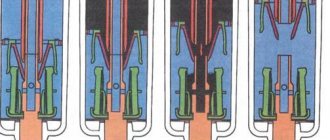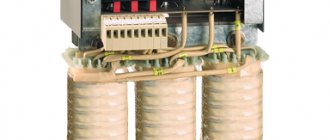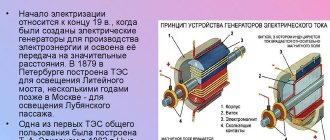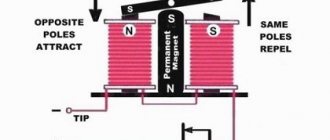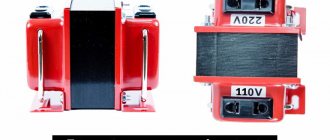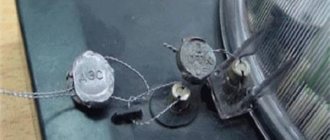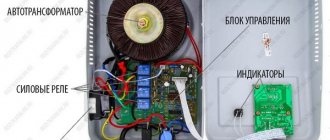Forced and gravity concrete mixer - what is the difference?
A gravity mixer prepares a concrete mixture by rotating the ingredients in a mixing bowl equipped with two or more massive blades. The blades lift the cement-sand composition, which, under the influence of gravity, falls to the bottom of the bowl, mixing. After a certain number of rotation cycles, a ready-to-use concrete mixture is obtained.
External view of an industrial forced-action planetary mixer Source Expertfasada.ru
In the case of preparing a cement-sand mortar with coarse aggregate, such as granite or limestone crushed stone, the finished concrete is well mixed. But if it is necessary to prepare a solution with fine aggregate or light ingredients, for example, sawdust, the forces of gravity are not enough to thoroughly mix the solution. It separates or sticks together into lumps, not reaching the required consistency.
A forced-action concrete mixer prepares concrete by forcefully mixing it with metal blades. Thanks to this, all the ingredients of the mixture are mixed most thoroughly and evenly. Some models of mixers are equipped with cascade mixing systems or a rotating bowl, which, together with rotating blades, works in a similar way to a kitchen mixer, quickly and efficiently mixing ingredients together. Various types of concrete are prepared in such units:
- wood concrete and other lightweight concrete;
- molding concrete;
- hard concrete;
- concretes with precise parameters of rigidity and plasticity.
Advantages of using planetary concrete mixers.
A planetary forced-action concrete mixer mixes the mixture with high quality and at the same time reduces the mixing time. The racks of the planetary concrete mixer are equipped with peripheral scrapers, which clean the internal walls of the mixing tank and direct the material to the active mixing zone.
The disadvantages of a planetary forced-action concrete mixer include:
- Increased drive power.
- The presence of a complex transmission that requires careful and regular maintenance.
- Sector type of unloading unit, which increases the time for unloading the finished mixture in full.
Forced action concrete mixer: design
A forced-action concrete mixer consists of the following main elements:
- mixing bowl;
- frames;
- electric motor-drive;
- mixing blades.
The volume of the mixing bowl can reach 2500 liters, due to which concrete mixers of this type are made of metal with a thickness of at least 6 mm.
Inside the bowl there are mixing blades Source Silteh.ru
Depending on the orientation of the bowl - vertical or horizontal, mixing units are equipped with different types of mixing devices:
- vertical single-blade;
- planetary;
- with a rotating or stationary bowl;
- horizontal rotating shafts;
- and etc.
Rotary units
Rotary concrete mixers are designed for the production of any types of mixtures with aggregate size up to 40 mm in diameter. This distinguishes it from other types of units that cannot work with such large aggregates. The general versatility and small dimensions of rotary units make them a good choice for “do-it-yourselfers”, but are absolutely not suitable for industrial production due to their low productivity.
Planetary units
The main advantage of planetary group mixers is their large capacity. With their use, it becomes possible to prepare 200 or more liters of concrete at a time. They have one significant drawback - low energy efficiency. The power of the electric motor of planetary concrete mixers is 5-12 kW, while other types of mixers are equipped with electric motors with a power of no more than 1.5 kW.
Sectional design of a planetary concrete mixer Source Beton-house.com
Chain drive models
You can make a forced-action concrete mixer with a chain drive with your own hands only using a drive with a distributor. In this case, the tank is selected for 700 liters or more. The shaft itself is installed in the central part. To fix it, you will need to make a strong frame. Most often, steel profiles are used for this purpose. If we consider the usual modification, then the starter can be selected as a manual type.
In this case, the suspension near the box is mounted on bearings. The frame itself should rest against the side supports. To better stabilize the structure, partitions are welded near the chamber. The motor in mixers must be located in the lower part, away from the loading hole. The gearbox for assembly is selected to be a worm gear. It is connected to the shaft through a pulley. The combs for these mixers are mainly of the curved type. All this allows you to successfully work with mixtures of high viscosity.
Units of famous brands
The Russian market offers a wide range of mixing units, among which the following models can be noted.
| Name | Volume, l. | Weight, kg | power, kWt | Number of revolutions per minute | Price, rub |
| Zitrek RN-150 | 150 | 200 | 1500 | 37 | 71000 |
| Lebedyan RN-80 | 80 | 285 | 1500 | 39,2 | 92250 |
| Imer MIX 360 | 360 | 360 | 6200 | 36 | 389000 |
| STROYMASH RN-200A | 200 | 215 | 1500 | 35,6 | 108000 |
| MISOM SO 351-150 | 150 | 172 | 1500 | 35 | 89000 |
| Zitrek RN SB-300 | 300 | 550 | 7500 | 26 | 172000 |
| Imer SPIN 15A | 60 | 78 | 1400 | 280 | 132500 |
External view of a factory-made horizontal concrete mixer Source Kblok.ru
What is a mortar mixer?
A mortar mixer is special equipment designed for mixing any mortars, as well as various bulk materials with or without the addition of water.
The body of the concrete mixer is assembled from a metal drum with a horizontal or vertical blade shaft equipped from the inside for mixing. The walls themselves and the drum bottom are made of sheet metal with a thickness of 2–4 mm - the value is selected based on the purpose of the mortar mixer and its capacity. Depending on the type of concrete mixer, the motor is installed on the side, bottom or top of the housing. The unit is designed either mobile (on wheels) or stationary (fixed).
Advantages of using mortar mixers versus hand mixing.
- Kneading speed. By increasing the speed parameter, the amount of solution produced increases.
- Mixture quality. The mixture becomes more homogeneous with mechanical mixing.
- Variety of uses. Batch mixtures are produced from various components on the same equipment.
- Specifications. The unit has high reliability, ease of use and maintainability.
Device: photo
Below is a photo gallery of the main mortar mixers and their components.
Operating principle
The mechanism of operation of the mortar mixer is quite simple: bulk components added to the drum one by one are mixed until homogeneous and, if necessary, diluted with water. The resulting consistency is manually or mechanically removed from the mixer container.
There are several main types of concrete mixers, differing from each other in various respects:
- A drum concrete mixer with blades is ideal for mixing mortar mixtures for construction work and preparing mortar for vibratory casting of single-ton concrete products.
- Drum type concrete mixer without blades is usually used when mixing the raw material for vibratory casting and marble concrete.
- The mortar mixer is designed for mixing until homogeneous both concrete components and any other bulk materials (including food industry products made from the corresponding metals).
All of the above equipment is suitable for mixing concrete mortar ingredients - sand, gravel/granite chips, cement, fiberglass, plasticizers and coloring pigments with water.
The principle of operation of concrete mixers is approximately the same: the gearbox mechanism drives either the drum part of the unit or a shaft with screw blades, due to which all components are mixed.
Performance
The productivity of mixing equipment shows the maximum amount of uniformly mixed concrete solution the machine is capable of delivering in one working cycle or a specific period of time. It depends on the mixing speed and the load level of the drum. All types of concrete mixing units are designed for a specific drum capacity, as well as a specific production capacity of the electric motor.
A short list of the performance of concrete mortar using the example of LOBAS mixers.
- Concrete mixers with blades are adapted to mix from 40 to 350 liters of ready-made solution in 250 seconds, operating at powers from 0.55 kW to 2.2 kW.
- Concrete mixers without blades are ready for mixing ready-made concrete mortar/pellets weighing from 40 to 200 kg at a power of 1.1 kW to 1.5 kW.
- Mortar mixers are prepared for mixing from 40 to 870 liters of concrete solution in 3-5 minutes at an operating power of 1.5–11 kW.
Practical experience in using a forced concrete mixer
Since the cost of factory samples of units can reach several hundred thousand rubles, the use of a forced-action concrete mixer in practice requires careful planning.
Model of a mobile concrete mixer with a protective mesh Source Maiso.ru
The purchase of such a mixer becomes economically justified when mixing at least 50-70 m3 of concrete on a construction site yourself. Therefore, the technology of building a house using such equipment implies the widespread use of concrete in all elements of the future building:
- installation of a strip or slab foundation;
- erection of walls;
- organization of blind areas, pouring concrete screeds, mauerlat;
- pouring stairs, concrete paths, car parking;
- erection of a fence;
- production of masonry, plaster and other finishing mixtures.
In all other cases, you should consider making a concrete mixer yourself.
Budget model of a vertical concrete mixer Source Stroy-podskazka.ru
Belt driven devices
Making a forced-action concrete mixer with a belt drive with your own hands is quite simple. First of all, a tank is selected for the model. In some cases, a regular barrel is used. In order to install stands for it, you will need to use a welding inverter. Quite often, partitions are welded on the sides in order to increase the stability of the structure.
After securing the tank, you can begin installing the central shaft. In this case, the drive will require a crank type. You can use it from a broken concrete mixer. The belt-type gearbox is installed next to the motor. In order to secure it, a small metal platform is made.
The motor should ultimately not come into contact with the frame. In order to install the gearbox, the starter is selected first. It is also important to use a camera limiter. All this will allow you to safely pour the mixture into the tank. Combs for such models can be used in various shapes. In this case, much depends on the capacity of the tank, as well as the power of the motor.
Is it possible to make a forced concrete mixer with your own hands?
In pursuit of savings, many home owners have implemented the manufacture of forced concrete mixers with their own hands. Regardless of the nuances, home-made units are divided into two types: horizontal and vertical.
Horizontal option
Horizontal concrete mixers are made from all kinds of metal barrels and other containers. The most labor-intensive process is the manufacture of the central shaft on which the mixing blades will be located. The blades rotate inside the barrel, ensuring high-quality mixing of the mixture. In this case, it becomes possible to simultaneously prepare a fairly large amount of the mixture, limited only by the strength of the container itself.
This version of a homemade mixer is preferable for its low cost, as well as high-quality mixing of solutions with light or fine aggregates. When building a house from wood concrete, sawdust concrete, polystyrene concrete and other lightweight concrete, preference should be given to this type of concrete mixer.
Appearance of a horizontal concrete mixer made by hand Source materialexpert.ru
Vertical option
The main element of vertical concrete mixers is a metal cylindrical tank, which must be both light so that a person can move the unit alone, and at the same time durable so that the structure can withstand the weight of the mixture. Inside the tank there is a shaft driven by an electric motor. Depending on the dimensions of the engine, it can be located either on the concrete mixer itself or connected to the shaft through an angular gearbox and a belt drive.
This version of the unit is technically more complex than the horizontal one, but it allows you to prepare several types of high-quality mixtures at once:
- heavy concrete with low moisture content;
- concrete with fine bulk aggregate: screenings, fine crushed stone or gravel.
- liquid cement, plaster and other solutions.
A vertical type concrete mixer allows you to “cover” absolutely all the needs when building a house from classical materials: brick, aerated concrete, etc. In addition, it becomes possible to mix mixtures for the production of semi-dry screed, paving slabs and other finishing materials, which will save the owner a lot of money.
Appearance of a homemade vertical concrete mixer Source vse-postroim-sami.ru
General information and classification
In various technological processes it is necessary to create a homogeneous mass consisting of several components. Mixing processes are used:
- to create an optimal surface of reacting substances;
- to change the physical state of substances (dissolution);
- to speed up chemical reactions, etc.
For example, when making silicate products, the mixture is prepared from sand, lime and water, while concrete products are made from cement, sand, crushed stone and water.
Depending on the mixing method, mixing machines can be mechanical, gas or combined.
According to technological purpose, depending on the physical state of the substances being mixed, mixing machines are divided into:
- machines for mixing liquid mixtures (sludge, clinker, glaze, dyes, etc.). They are cyclic and continuous; these include tap, slurry, propeller, turbine, planetary and other mixers;
- machines for mixing dry powder and granular materials (possibly with subsequent moistening). These include mainly mechanical forced-action mixers (paddle, runner, planetary, etc.);
- machines for preparing coarse suspensions (concrete mixtures, mortars, ceramic and other masses).
Mixers for preparing concrete and mortar mixtures are classified:
- for technological purposes - for the preparation of concrete and mortars;
- by the nature of the work - cyclical and continuous action;
- according to the method of mixing - gravitational and forced action;
- according to the design of the working body - with a cylindrical and pear-shaped drum, with a double-cone drum, with a vertically located mixing shaft, with a horizontal mixing shaft;
- according to the method of relocation - mobile and stationary.
In cyclic mixers, the preparation of concrete and mortar mixtures is carried out in separate portions.
In continuous mixers, the input of components and the output of the finished mixture occurs continuously, as a result of which their productivity exceeds the productivity of cyclic mixers. The main parameter of continuous mixers is productivity.
In table 1 shows the technical characteristics of domestic mixers for concrete mixtures.
Table 1
Technical characteristics of mixers for concrete mixtures
| Index | Gravitational | Compulsory action | |||||||||||
| Loading volume, l | 100 | 250 | 500 | 750 | 1200 | 1500 | 2400 | 3000 | 250 | 500 | 750 | 1200 | 1500 |
| Maximum aggregate size, mm | 60 | 60 | 60 | 80 | 120 | 120 | 120 | 150 | 40 | 70 | 70 | 70 | 70 |
| Engine power, kW (no more) | 0,6 | 1 | 3 | 4 | 13 | 13 | 25 | 28 | 5 | 14 | 28 | 30 | 40 |
| Weight, t | 0,25 | 0,8 | 1,8 | 1,3 | 4,0 | 4,0 | 7,6 | 8,0 | 1,3 | 2,0 | 3,5 | 4,0 | 5,0 |
The cost of a homemade forced-action concrete mixer
The cost of a homemade horizontal concrete mixer consists of the following components:
- Metal barrel with a volume of 200 liters – 500 rubles.
- Electric motor 1.5 kW with supports and reduction gearbox from a walk-behind tractor – 17,500 rubles.
- Materials for metal frame, blades, shaft - 2500 rubles.
- Sealing cap, seals and bearings - 200 rubles.
Total: from 20,700 rubles.
Estimated costs for the production of a vertical concrete mixer weighing 150 kg and volume 80 liters. will be:
- Metal sheets 6 and 8 mm thick – 11,750 rubles.
- Payment for rolling and plasma cutting work – 10,300 rubles.
- Worm gear – 6500 rub.
- Turning and welding work – 5000 rubles.
- Electric motor 1.5 kW, bearings – 9500 rub.
- Paint and other materials – 4000 rubles.
Total: from 47,050 rub.
Bowl of an industrial concrete mixer with a volume of 1500 liters Source Gbitrade.ru
Gravity concrete mixers
Mixing of components in gravity mixers occurs in drums, to the inner walls of which blades are attached. When the drum rotates, the mixture is raised to a certain height by the blades, as well as by frictional forces, and then dropped down. To ensure the homogeneity of the mixture, it is necessary to perform at least 30...40 cycles of raising and dumping the mixture in the drum. To ensure free movement of the mixture in the drum, its volume must be 2.5...3 times the volume of the mixture. The rotation speed of the drum is low, since otherwise the centrifugal forces of inertia will prevent the free movement of the mixture.
Concrete mixers are manufactured with tilting and stationary drums, which are pear-shaped, conical and cylindrical (Fig. 1).
Rice. 1. Designs of mixing drums : a - double-cone shape; b - pear-shaped; c - cylindrical shape
Based on the design of the working body, gravity mixers are distinguished:
- with a rotating drum on support rollers;
- with a rotating drum on a central axle.
The advantages of gravity mixers are simplicity of design, the ability to prepare mixtures with coarse aggregates up to 150 mm or more, low wear of working parts, ease of maintenance and low cost of preparing concrete and mortar mixtures.
In Fig. Figure 2 shows a gravity concrete mixer with a volume of 500 liters (by loading) with a pear-shaped drum. Dosed bulk materials enter the loading ladle 4, which moves along the guides 6. The ladle is lifted by a rope 5 passing along a deflecting block 7 onto a pulley, consisting of a fixed 1 and a movable holder of blocks 3, which is moved by a hydraulic cylinder 2. When the lower rollers of the ladle interact with the stop installed in the guides, the bottom of the bucket opens and a tray is formed, through which the materials enter the mixing drum 8, mounted on the traverse 11, which rests with its fingers on the racks 16 attached to the frame 17. Rotation of the drum is transmitted by the engine 13 through the gearbox 12, located in traverse The finished mixture is unloaded when the drum is tilted as a result of the traverse being rotated by a hydraulic cylinder 14, a gear sector 10 and a gear 9 mounted on the traverse pin.
The mixer is equipped with a hydraulic drive 15, consisting of a motor, a hydraulic pump and distribution fittings.
Rice. 2. Gravity concrete mixer with loading bucket
A concrete mixer with a conical tilting drum (Fig. 3) consists of a frame 9, on which a crossbeam 8 is installed in special bearings built into the racks 7, carrying the mixing drum 4. The latter rests freely on rollers 5 and 10 and is secured against axial displacement by supporting rollers 6. The drum is driven into rotation by an electric motor through a gearbox and a ring gear 3 attached to the drum. The components are loaded into the drum through funnel 2. The finished mixture is unloaded when the drum is tilted as a result of turning the traverse by pneumatic cylinder 1.
A band 11 is attached to the cylindrical part of the drum, resting on support rollers and a gear ring 3 that engages with the gear wheel of the gearbox output shaft.
Currently, stationary concrete mixers with a volume of 750 and 1200 liters (by load) are produced, made according to a more progressive design - with a central drive.
Shown in Fig. 4, the mixer has a compact drum 1, in which six quick-release blades 2 are installed. The drum is mounted with a hub on the output shaft of the gearbox 3, built into the traverse 10 and rotating from the engine 4. The traverse is installed
Rice. 3. Stationary gravity concrete mixer with tilting drum (on support rollers)
in bearings on frame struts 9 and with the help of hydraulic cylinder 6 and lever 5 can occupy different positions, as a result of which the drum will have corresponding positions for loading, mixing and unloading. The mixer has an individual hydraulic drive, consisting of a pumping station 8 and an electrically controlled distributor 7. The advantage of this mixer lies not only in good design solutions of the drive (open gears are excluded), but also in the shape of the drum and blade apparatus, which makes it possible to ensure the quality of the mixture in a time not exceeding 60 s. As a result of the compact placement of components, the overall dimensions of the machine have also been reduced.
Rice. 4. Gravity concrete mixer with central drive (on a central axle)
In factories with high productivity (over 100 m3/h), continuous mixers are used (Fig. 5, 6). The components are mixed in a cylindrical drum 1, inside of which blades 3 are installed along a helical line. When the drum rotates, the components of the mixture, flowing in a continuous flow through the loading funnel 7, are moved by the blades in the circumferential and axial directions, as a result of which they are mixed and continuously move towards the discharge end of the drum. Water is supplied to the drum through pipe 6 through a sprayer 4. The drum is rotated by an engine 8 through a coupling 10, a gearbox 11, a gear 12 and a ring gear 5 attached to the drum. The drum is freely supported by tires 2 on rollers 13 mounted on the frame 9. Axial movements of the drum are prevented by thrust rollers 14.
203
Rice. 5. Continuous Gravity Concrete Mixer
Types of concrete mixers
Today, not a single construction project can be completed without concrete mixers, because it is physically very difficult to mix a solution of cement, sand and crushed stone with your own hands. Therefore, it is not surprising that this process has long been automated.
It must be said that on construction sites you can see a variety of designs of concrete mixers.
However, they are all conditionally divided into two types:
- Gravitational action;
- Forced action.
Now let's look at the features of each type.
Gravity type concrete mixer
Gravity type concrete mixer
The principle of operation of the gravity apparatus is that the mixture is placed in a special drum, which rotates. In this case, the solution rotates with it and falls away from the walls under the force of gravity. There are blades on the walls of the drum that improve the quality of the kneading and also prevent the solution from sticking.
This type of concrete mixer is good because it can be used to mix not only concrete solutions, but also any other types of liquid and dry mixtures.
Forced type concrete mixer
The main difference between devices of this type is that the drum in them remains motionless, and stirring occurs due to the rotation of the blades. Such concrete mixers can be used when mixing any types of concrete mixtures.
Even a not-so-powerful mixer of this type is capable of producing 0.1-0.45 cubic meters of solution in five minutes of operation. Moreover, the concrete will be more homogeneous than the mixture made in other types of machines. Performance largely depends on the volume of the drum, as well as the design of the blades.

